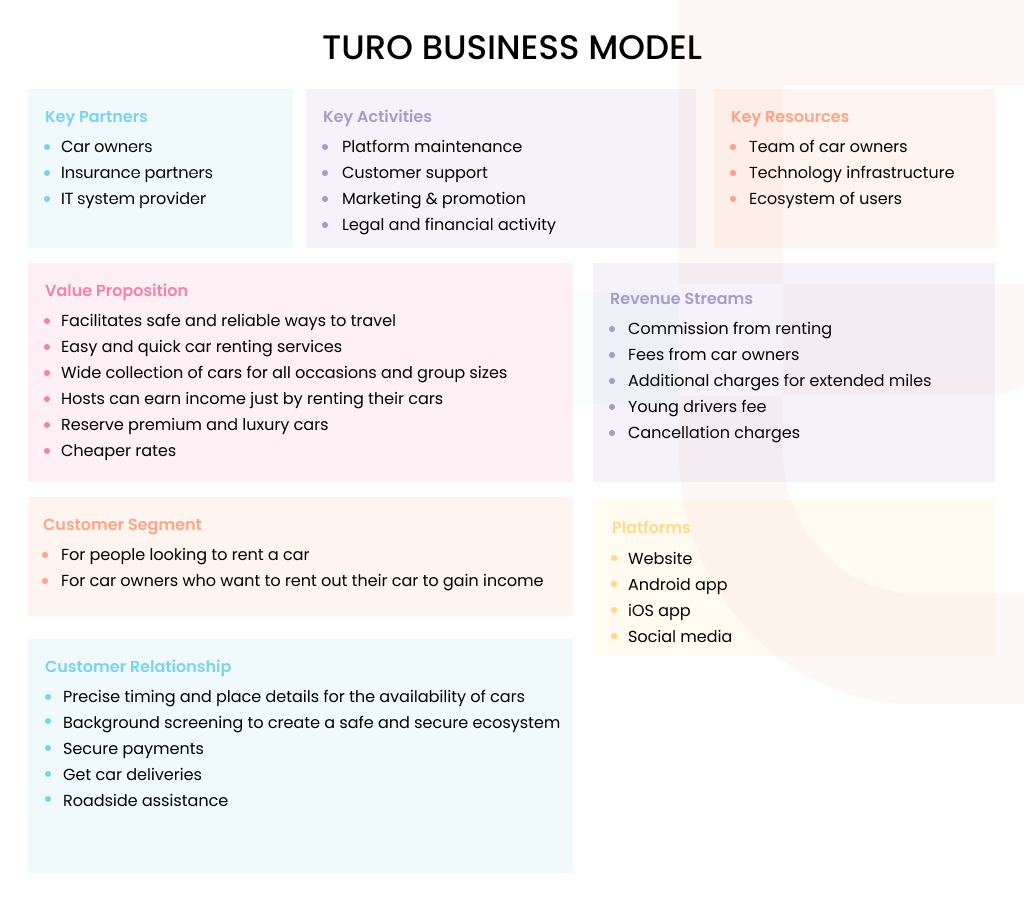
In the ever-evolving industry of car-sharing, Turo is a prominent performer in the market. Turo has introduced a diverse and unique business model to reshape the traditional car renting industry. It offers a convenient approach for users to rent a conveyance of their choice using their smartphones. Turo follows a straightforward approach to facilitate car renting services. Let’s get to know how does Turo works to make money and Turo business model.
The Success Story of Turo
The peer-to-peer carsharing market size was valued at US Dollar 2214.2 millions in 2025, and it is predicted to gain a ratio of US Dollar 6928.6 millions by the end of 2030 with a CAGR of 17.7% from the 2025 to 2030 forecasting period.
In the global peer-to-peer car-sharing market share, North America comprises 35% share while Europe and Asia-Pacific consist of 25% and 20% share respectively. So we can say that the changing ride-hailing standards are affecting the growth of the industry, where Turo like App give their subsequent share to satisfy the market demands.
The company operates beneath the principle of a sharing economy. Turo is a peer-to-peer car-sharing startup from America.
Turo, formerly known as RelayRides, was founded back in the days of 2009. The Turo business model offers a quick and easy approach for users and car owners. The company’s journey has been marked by innovation, growth, and some regulatory challenges.
At first, the business was launched in Boston, but late in 2010, the company expanded to the San Francisco location, and at present, its headquarters are held in San Francisco.
Turo teamed up with General Motors and its OnStar division in 2012 with an aim to enable renters to unlock GM cars with their mobile phones without having to install any additional technology.
However, this approach did not last long; Relayrides discontinued its in-car device and its onstart technology integration to proceed towards with in-person key exchange.
Relayrides changed its name to Turo in November 2015; the transformation was meant to describe the company’s shift from short-term to long-term rental services.
In the timespan of 2016 and 2017, Turo launched its services in Alberta, Ontario, Quebec, and even in the United Kingdom.
Turo modified its terms of service in 2019 to prohibit hosts from listing their cars on any other car-sharing platforms.
Moreover, turo also featured on the list of Glassdoor’s best places to work in 2023.
At present, Turo is available in more than 5,000 locations across the US, Canada, and the UK, with 450,000 vehicle listings.
Furthermore, the company has launched its apparel and clothing goods, where consumers can purchase like any other shopping website.
Company Facts and Fundings
| Legal Name | Turo Inc. |
|---|---|
| Formerly known as | RelayRides |
| Founders | Nabeel Al-Kady, Shelby Clark, Tara Reeves |
| Founded Date | 12 Aug 2009 |
| Headquarters | San Francisco, US |
| Hub Tags | Unicorn |
| Industry | Taxi service market, Auto commerce |
| Area Served | US, Canada, and UK |
Turo has raised a total of $502.6 million in funding from 14 rounds.
| Date | Transaction Name | Money Raised |
|---|---|---|
| Aug 29, 2023 | Secondary Market | – |
| Apr 1, 2022 | Venture Round | $35.2M |
| Feb 5, 2020 | Series E | $30M |
| July 17, 2019 | Series E | $250M |
| Apr 16, 2018 | Secondary Market | $5M |
| Sep 6, 2017 | Series D | $104M |
| Nov 3, 2015 | Series C | $47M |
| Jan 24, 2014 | Series B | $25M |
| Jan 23, 2013 | Series A | – |
| Oct 26, 2011 | Series A | – |
How does Turo works? Turo Business Model Explained
Value Proposition
- Turo operates in myriad locations across the US, Canada, and the UK, making it the largest online car sharing economy.
- Users can quickly and easily rent cars just by following simple steps.
- Turo provides cheaper rates compared to traditional rental providers.
- Users can select from a wide range of listed cars that meets their specific requirements.
- The firm even allows an opportunity for younger drivers under 25 to rent cars.
- Apart from user perspectives, Turo provides a great opportunity for car owners to earn money.
- Car owners can set the pricing strategy on their own.
Customer Relationship
- The consumer gets precise timing and location details to rent and pick up their booked cars.
- The platform is integrated with a secure payment infrastructure, and it accepts debit and credit card payments.
- Turo proffers background screening of drivers for safety and security reasons. So both hosts and guests can enjoy the trip without any threats.
- Users can choose to get their rented vehicles delivered to their location.
- Moreover, the business provides 24*7 customer support and roadside assistance whenever users feel stuck during their trip.
Turo business model revolves around connecting users with car owners to fulfill their requirements. Basically, it allows guests to discover the cars of their liking to rent, and on the other hand, car owners can generate income by leasing their vehicles.
Want to build your car-sharing app like Turo? Explore our product specifically designed to meet the taxi market demands and avails an easy-to-use approach.
How Does Turo Works?
A straightforward and effective workflow is offered under the Turo business model.
- At first, users are required to register their accounts by adding an email or contact number.
- Now, users have to add their location and timings, and they will be shown available cars to rent.
- Users can select a vehicle of their choice and check out the estimated prices.
- After checking out the listing details, clients can confirm their bookings.
- Here, users can pick up the car keys from the renters on their own or can choose to receive delivery, which will apply the additional charges.
- After getting the keys, users can hit the road and leave reviews regarding the overall experience they had with the Turo.
What are the Revenue Channels of Turo?
In the Turo business model, we can find diverse streams of revenue, which are as follows;
Service Fees:
This is one of the core revenue channels of the company. Turo charges service fees to both car owners and renters for using the platform. These fees are typically counted on the percentage of the rental price. This factor may vary depending on the sorts of vehicle and insurance policies selected by the users and hosts.
Insurance Commissions:
The firm even offers insurance coverage to both vehicle owners and renters. Here, the company partners with insurance companies to provide this coverage. Turo earns commissions from these insurance providers for policies purchased by car owners and renters. This one also counts as a great source of income.
Young Drivers Fees:
Turo charges a specific fee for young drivers aged between 18 – 25 in the United States and for the age group of 18 – 24 in the UK. So, the young driver’s fees are also considered as a revenue source.
Supplementary Fees:
Turo charges myriad fees to guests in the form of add-on services or extra kilometers. Moreover, Turo also offers to rent out luxurious cars and charges some additional fees for renting.
Turo Go:
The business offers a specific program named Turo Go, where renters can access the rented vehicles with their smartphones. So Turo may charge fees to use such advanced tech services.
Cancellation Fees:
Things can happen under some circumstances when users have to cancel their bookings. In this case, if the user cancels their bookings after one hour of booking or before 24 hours of trip starts, then they are eligible to get free cancellation. After the free cancellation period, users are required to pay cancellation fees as described in the policies.
In the Mobility as a Service concept, some revenue streams are common, like trip fees, extra miles fees, etc., that we can find in Turo as well. However, we can say that the Turo business model is diverse, allowing it to earn a hefty amount of profit.
Competitors in the Carsharing Economy
The car-sharing economy is way bigger where Uber and Lyft-like businesses are competing. So let’s get to know the key competitors in the carsharing economy.
Uber
Uber is one of the old players in the market with the biggest popularity. Uber business model revolves around providing taxi-hailing services to users at their fingertips. Uber is not only offering commuting services, but it’s also active in the logistics segment.
Lyft
A USA based firm, Lyft follows the peer to peer car sharing concept. Lyft’s business model comprises the same characteristics as Uber. Lyft works to connect users with the nearby drivers to fulfill their ride hailing demands.
Getaround
Another peer-to-peer car-sharing firm from the United States. Getaround works to facilitate car renting services to consumers at much cheaper rates. On the other hand, it avails a great opportunity for hosts to earn money by renting their car.
So Turo is competing with major apps like Uber in the industry; however, the Turo business model has its own unique strategy, making it stand out in the market.
What Makes Turo Successful?
The success of Turo can be attributed to several key factors, which are as follows;
Flexible Business Model
As we know, under the Turo business model, the brand does not offer consumers goods. So there is no need for inventory management and logistics channels. Instead, the company works to build networks of cars where users can find their ideal car type and rent it accordingly without going through any ordering and tracking procedure.
Insurance Coverage
Turo offers its own insurance coverage for both car owners and renters. This includes liability insurance and physical damage protection, which provides coverage in case of accidents or damage to the rented vehicle. Owners can prefer to use Turo’s insurance, their own personal insurance, or a combination of both.
User-friendly Technology
Turo’s user-friendly mobile app and website simplify the process of listing cars, booking rentals, and managing transactions. Features like Turo Go, which enables remote unlocking of vehicles, and convenience help to improve the user experience.
Extended Service Area
Turo expanded its services internationally, reaching markets beyond the United States. This global expansion allowed the company to tap into a broader customer base and extend its reach to travelers worldwide.
Diverse Selection of Vehicles
Turo allows a wide range of vehicles to be listed on its platform, from everyday cars to high-end luxury vehicles. This diversity caters to various customer needs and preferences, making it a versatile option for renters.
Customer Support
Turo provides excellent customer support to assist car owners and renters with their issues. Moreover, the company also pays attention to solving issues that may occur during the renting process or during the ongoing trip.
Secure Environment
Turo has implemented trust and safety measures, including user reviews and ratings, insurance coverage, and 24/7 constant customer support. These measures build trust among users and ensure that both guests and hosts can feel secure during transactions.
With its commitment to innovation, safety, and user experience, Turo has become a prominent app in the sharing economy.
Want to Build a P2P Car Sharing Platform Like Turo?
The growing demand for car-sharing services has inspired entrepreneurs to start their own car-sharing businesses. With the help of technological advancement, it’s not difficult to step into the market. Entrepreneurs are required to approach the right tech team that can guide further.
Elluminati is a leading firm with expertise in the tech field. Our team of programmers specializes in developing robust app like Turo that can gear up your traditional business. Connect with our industry experts and get the right assistance.
In conclusion, we can say that the Turo business model has harnessed the power of technology at its best to benefit car renters and car owners while earning a great amount of income. With its diverse revenue streams, Turo has carved a unique path in the ride-hailing marketplace.










